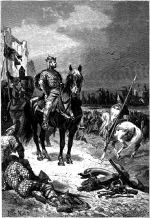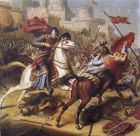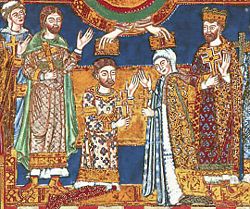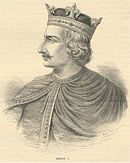Matilda of Flanders
| Matilda of Flanders | |
|---|---|
| Queen consort of the English Duchess consort of Normandy | |
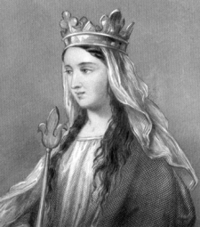
| |
| Consort | 25 December 1066 – 2 November 1083 |
| Consort to | William I the Conqueror |
| Issue | |
| Robert II Curthose William II Rufus Adela, Countess of Blois Henry I Beauclerc | |
| Royal House | House of Normandy |
| Father | Baldwin V, Count of Flanders |
| Mother | Adela Capet |
| Born | c. 1031 |
| Died | 2 November 1083 (aged c. 52) |
| Buried | Abbaye aux Dames Caen, Normandy |
Matilda of Flanders (c. 1031 – 2 November 1083) was Queen consort of the Kingdom of England and the wife of William I the Conqueror.
She was the daughter of count Baldwin V of Flanders, and Adèle (1000-1078/9), daughter of Robert II of France.
They had eleven children, two were kings of England, William Rufus (1056 – 1100), who was succeeded by Henry Beauclerc (1068–1135). Theirs was thought to have been a loving marriage until she sided with her son, who opposed William I. But she reconciled them and they remained at peace until her death.
Her life
Matilda (or "Maud") was the daughter of count Baldwin V of Flanders, and Adèle (1000-1078/9), daughter of Robert II of France, and was descended on her father's side from King Alfred the Great of England. At 4'2" (127 cm) tall, she was, according to the Guinness Book of Records, England's smallest queen.
Legend has it that when the emissary of William, Duke of Normandy (later king of England as William the Conqueror), came to ask for her hand in marriage, Matilda considered herself far too high-born to consider marrying him, since he a considered a bastard.[1] The story goes that when her response was reported to him, William rode from Normandy to Bruges, found Matilda on her way to church, dragged her off her horse by her long braids, threw her down in the street in front of her flabbergasted attendants, and then rode off. Another version relates that William rode to Matilda's father's house in Lille, threw her to the ground in her room (again by the braids), and either hit her or violently shook her before leaving. Naturally her father, Baldwin, took offense at this but, before they drew swords, Matilda settled the matter. [2] by deciding to marry him, and even a papal ban, by Pope Leo IX (on the grounds of consanguinity) did not dissuade her.
William married Matilda in 1053 in the Cathedral of Notré Dame at Eu, Normandy (Seine-Maritime). William was about 24 years old and Matilda was 22. William is said to have been a faithful and loving husband, and their marriage produced four sons and six or seven daughters. In repentance for what was considered by the pope a consanguine marriage (they were distant cousins), William donated St. Stephen's church (l'Abbaye-aux-Hommes) and Matilda donated Sainte-Trinité church (Abbaye aux Dames).
There were rumors that Matilda had been in love with the English ambassador to Flanders, a Saxon named Brihtric, who declined her advances. Whatever the truth of the matter, years later when she was acting as Regent for William in England, she used her authority to confiscate Brihtric's lands and threw him into prison, where he died.
When William was preparing to invade England, Matilda outfitted a ship, the Mora, out of her own money and gave it to him. For many years it was thought that she had some involvement in the creation of the Bayeux Tapestry (commonly called La Tapisserie de la Reine Mathilde in French), but historians no longer believe that; it seems to have been commissioned by William's half-brother Odo, Bishop of Bayeux, and made by English artists in Kent to coincide with the building of the Bayeux Cathedral.
Matilda bore William 11 children, and he was believed to have been faithful to her, at least up until the time their son Robert rebelled against his father and he discovered that Matilda had been secretly sending her son money.
The problem with Robert began when his brothers William and Henry poured filthy water on him and William did not punish the boys for disrespecting Robert, his heir. Eventually, the situation evolved into a large scale Norman rebellion. It ended only when King Philip added his military support to William's thus allowing him to confront Robert and his forces, who were based at Flanders. Also, during the battle in 1079, William was unhorsed and wounded by Robert, who lowered his sword only after recognizing him. The embarrassed William returned to Rouen, abandoning the expedition. William revoked Robert's inheritance. At Easter 1080 father and son were reunited by the efforts of Queen Matilda, and a truce lasted until she died in 1083. Robert seems to have left court soon after the death of his mother's death, and spent several years traveling throughout France, Germany and Flanders.
Adding to the separation between father and son, at a battle in January 1079, Robert unhorsed his father William in combat and succeeded in wounding him, stopping his attack only when he recognized his father's voice. Humiliated, William cursed his son, then raised the siege and returned to Rouen. But at Easter 1080, father and son were reunited by the efforts of Matilda, and a truce lasted until she died in 1083.
After she died, in 1083 at the age of 51, William became tyrannical, and people blamed it on his having lost her, and perhaps the trouble with his son, Robert. Contrary to the belief that she was buried at St. Stephen's, also called l'Abbaye-aux-Hommes in Caen, Normandy, where William was eventually buried, she is entombed at l'Abbaye aux Dames, which is the Sainte-Trinité church, also in Caen. Of particular interest is the eleventh century slab, a sleek black stone decorated with her epitaph, marking her grave at the rear of the church. It is of special note since the grave marker for William was replaced as recently as the beginning of the nineteenth century. Years later, their graves were opened and their bones measured, proving their physical statures.
Children
Some doubt exists over how many daughters there were. This list includes some entries which are obscure.
- Robert Curthose (c. 1054 – 1134), Duke of Normandy, married Sybil of Conversano, daughter of Geoffrey of Conversano
- Adeliza (or Alice) (c. 1055 – ?), reportedly betrothed to Harold II of England (Her existence is in some doubt.)
- Cecilia (or Cecily) (c. 1056 – 1126), Abbess of Holy Trinity, Caen
- William Rufus (1056 – 1100), King of England
- Richard, Duke of Bernay (1057 – c. 1081), killed by a stag in New Forest
- Alison (or Ali) (1056 -c. 1090), was once announced the most beautiful lady, died unmarried.
- Adela (c. 1062 – 1138), married Stephen, Count of Blois
- Agatha (c. 1064 – c. 1080), betrothed to (1) Harold of Wessex, (2) Alfonso VI of Castile
- Constance (c. 1066 – 1090), married Alan IV Fergent, Duke of Brittany; poisoned, possibly by her own servants
- Matilda (very obscure, her existence is in some doubt)
- Henry Beauclerc (1068–1135), King of England after his brother William died, married (1) Edith of Scotland, daughter of Malcolm III, King of Scotland, (2) Adeliza of Louvain
Gundred (c. 1063 – 1085), wife of William de Warenne (c. 1055 – 1088), was formerly thought of as being yet another of Matilda's daughters, with speculation that she was William I's full daughter, a stepdaughter, or even a foundling or adopted daughter. However, this connection to William I has now found untrue.
Legacy
Matilda's legacy is best seen through her royal lineage and descendants. She was a seventh generation direct descendant of Alfred the Great from her father, Baldwin, and her marriage to William strengthened his claim to the throne. All sovereigns of England, Great Britain and the United Kingdom are directly descended continuously from her, including Queen Elizabeth II. For this reason she is considered an important and valuable queen consort.
Matilda, sent son, Robert, money without the Willaim's knowledge (he was notoriously poor most of the time) which caused some dissatisfaction between her and William. Her efforts to reconcile their son, Robert, with his father were successful up until the time of her death when Robert left home and traveled in Europe until his father's death. The rivalry between sons of a king often leads to war and further divisions of the nobles and royal families, she sought to prevent a division in her family. William I divided his inheritance to avoid this potential problem. He left the Duchy of Normandy to Robert and to William Rufus the control of the Kingdom of England. The third son, Henry Beauclerc, was given money to buy land.
For many years Matilda (and her maids) was credited with the creation of the Bayeux Tapestry, but primarily by the French. Current scholarship believes that the half-brother of William the Conqueror, Odo, Bishop of Bayeux, commissioned the enormous tapestry to coincide with the building of the cathedral at Bayeux and in fact the work was done in Kent, under Odo's supervision. Rivalry concerning the tapestry and other issues still exists between the English and the French, though lightheartedly for the most part.
In popular culture
Her love for her husband is referenced in the Award-winning play, Angels in America.
On screen, Matilda has been portrayed by Jane Wenham in the two-part BBC TV play Conquest (1966), part of the series Theatre 625, and by Anna Calder-Marshall in the TV drama Blood Royal: William the Conqueror (1990).
| English royalty | ||
|---|---|---|
| Preceded by: Edith of Wessex |
Queen consort of the English 25 December 1066 – 2 November 1083 |
Succeeded by: Matilda of Scotland |
Notes
ReferencesISBN links support NWE through referral fees
- Cantor, Norman F. The Civilization of the Middle Ages, Harper Perennial, 1994. ISBN 0060925531
- Douglas, David C. William the Conqueror; the Norman impact upon England. Berkeley, CA: University of California, 1964. ISBN 0520003500
- Fettu, Annie. Queen Matilda: Princess of Flanders, Duchess of Normandy, Queen of England, circa 1032 - 1083, Cully: Orep Editions, 2005. ISBN 9782912925817
- Hilliam, Paul. William the Conqueror: First Norman King of England, Rosen Publishing Group, 2005. ISBN 1404201661
- Lewis, Hilda Winifred. Wife to the bastard, New York, D. McKay Co., 1966. OCLC 1378149
- Strickland, Agnes. Lives of the queens of England 1. Matilda of Flanders. Matilda of Scotland. Adelicia of Louvaine. Matilda of Boulogne. Eleonora of Aquitaine. - 1840, London: Colburn 1840. (7 Editions) OCLC 165803070
- _________________. Lives of the queens of England from the Norman conquest: With anecdotes of their courts; (Now first published from official records and other authentic documents, private as well as public), Philadelphia: Lea & Blanchard, 1841. (From the 2nd London ed., with corrections and additions) OCLC 8830518
George, Duke of Cumberland (1702-1707) · Mary of Modena (1685-1688) · Catherine of Braganza (1662-1685) · Henrietta Maria of France (1625-1649) · Anne of Denmark (1603-1619) · Philip II of Spain (1554-1558) · Lord Guildford Dudley (1553) · Catherine Parr (1543-1547) · Catherine Howard (1540-1542) · Anne of Cleves (1540) · Jane Seymour (1536-1537) · Anne Boleyn (1533-1536) · Catherine of Aragon (1509-1533) · Elizabeth of York (1486-1503) · Anne Neville (1483-1485) · Elizabeth Woodville (1464-1483) · Margaret of Anjou (1445-1471) · Catherine of Valois (1420-1422) · Joanna of Navarre (1403-1413) · Isabella of Valois (1396-1399) · Anne of Bohemia (1383-1394) · Philippa of Hainault (1328-1369) · Isabella of France (1308-1327) · Marguerite of France (1299-1307) · Eleanor of Castile (1272-1290) · Eleanor of Provence (1236-1272) · Isabella of Angoulême (1200-1216) · Berengaria of Navarre (1191-1199) · Eleanor of Aquitaine (1154-1189) · Matilda of Boulogne (1135-1152) · Geoffrey V, Count of Anjou (1141) · Adeliza of Louvain (1121-1135) · Matilda of Scotland (1100-1118) · Matilda of Flanders (1066-1083)
Credits
New World Encyclopedia writers and editors rewrote and completed the Wikipedia article in accordance with New World Encyclopedia standards. This article abides by terms of the Creative Commons CC-by-sa 3.0 License (CC-by-sa), which may be used and disseminated with proper attribution. Credit is due under the terms of this license that can reference both the New World Encyclopedia contributors and the selfless volunteer contributors of the Wikimedia Foundation. To cite this article click here for a list of acceptable citing formats.The history of earlier contributions by wikipedians is accessible to researchers here:
The history of this article since it was imported to New World Encyclopedia:
Note: Some restrictions may apply to use of individual images which are separately licensed.
